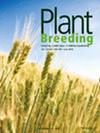Isolation and evaluation of novel male sterile and self‐incompatible mutant lines of mungbean (Vigna radiata L.)
IF 1.8
4区 农林科学
Q2 AGRONOMY
引用次数: 0
Abstract
Heterosis has long been harnessed in crop production, and while crop fertility lays the groundwork for leveraging heterosis, there remains a dearth of comprehensive data regarding genic male sterility in mungbean. Mungbean (绿豆(Vigna radiata L.)新型雄性不育和自交不亲和突变品系的分离与评价
长期以来,作物生产中一直在利用异交现象,而作物生育力为利用异交现象奠定了基础,但有关绿豆基因雄性不育的全面数据仍然匮乏。绿豆(Vigna radiata (L.) Wilczek)是一种自花授粉作物,在 F1 代杂交种子产量中表现出显著的杂种活力,这表明开发杂交品种有可能推动绿豆产量超越现有的高原水平。通过 600 Gy 伽马辐照,在转基因 4 号的 M3 代中诱导、分离、稳定和评估了一个新的雄性不育突变体。雄性不育系与野生型亲本杂交,以探索雄性不育的遗传模式。花粉不育是通过乙酰卡明试验验证的,而柱头活力则是通过过氧化氢来确定的。虽然所有 F1 植株都开出了可育花,但 F2 代可育株与雄性不育株的分离比为 3:1,表明雄性不育受单个隐性基因 mms 控制。此外,存在于花药柱内的截短柱头抑制了花粉在花期的有效接收,通过对花蕾的轻微切割缩短了退雄时间,并提高了杂交种子生产过程中的异花授粉。这两个突变体的分离将极大地推动全球绿豆杂交育种计划。
本文章由计算机程序翻译,如有差异,请以英文原文为准。
求助全文
约1分钟内获得全文
求助全文
来源期刊

Plant Breeding
农林科学-农艺学
CiteScore
4.40
自引率
5.00%
发文量
74
审稿时长
3.0 months
期刊介绍:
PLANT BREEDING publishes full-length original manuscripts and review articles on all aspects of plant improvement, breeding methodologies, and genetics to include qualitative and quantitative inheritance and genomics of major crop species. PLANT BREEDING provides readers with cutting-edge information on use of molecular techniques and genomics as they relate to improving gain from selection. Since its subject matter embraces all aspects of crop improvement, its content is sought after by both industry and academia. Fields of interest: Genetics of cultivated plants as well as research in practical plant breeding.
 求助内容:
求助内容: 应助结果提醒方式:
应助结果提醒方式:


